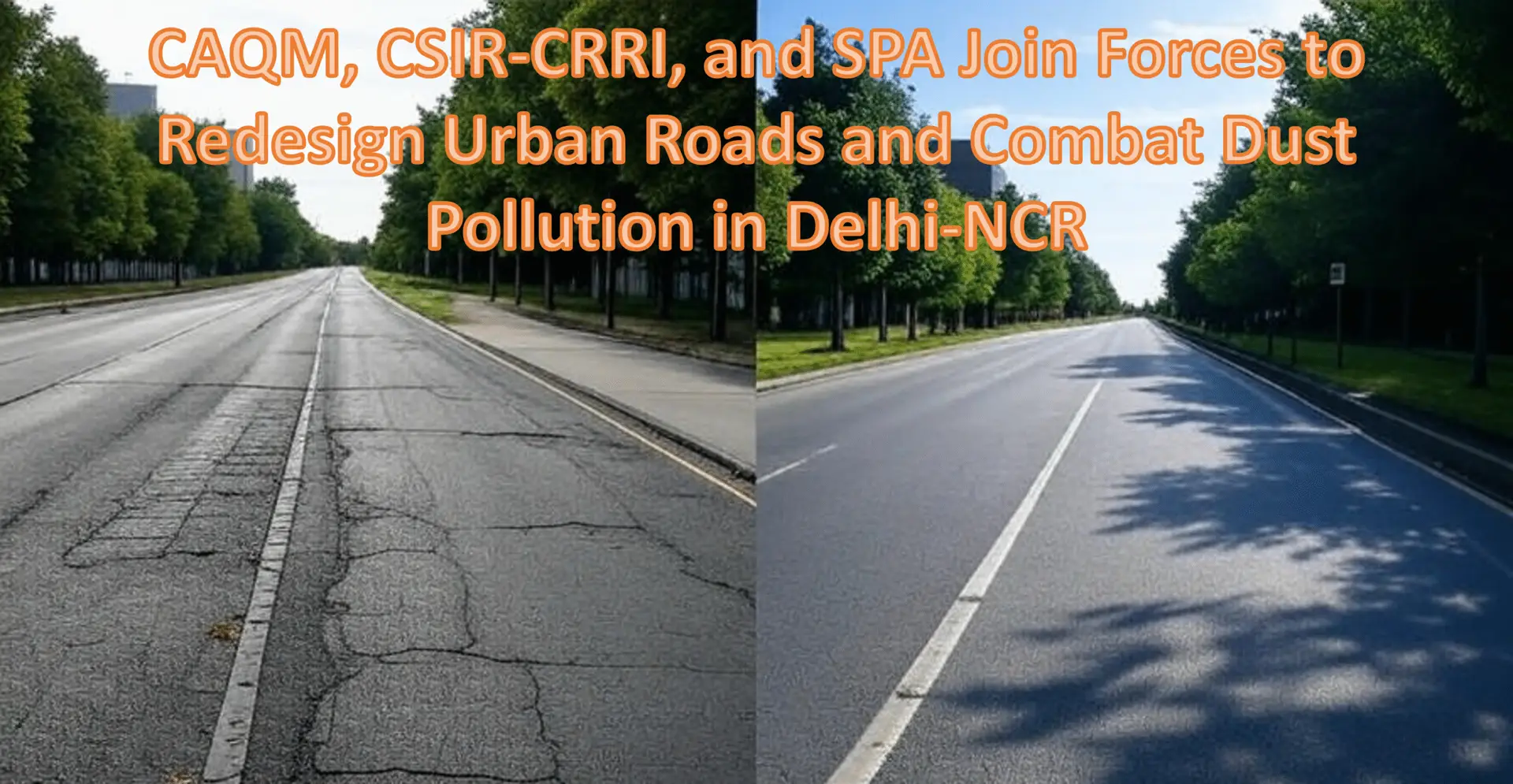Tripartite MoU promises scientifically engineered, greener roads to improve air quality across the region
In a decisive move aimed at reducing road dust pollution — a major contributor to deteriorating air quality in the National Capital Region (NCR) — the Commission for Air Quality Management in NCR and Adjoining Areas (CAQM) has signed a tripartite Memorandum of Understanding (MoU) with the CSIR-Central Road Research Institute (CSIR-CRRI) and the School of Planning and Architecture (SPA), New Delhi. This collaboration aims to implement a scientifically developed Standard Framework for the redevelopment of urban roads that focuses on construction quality, greening, and smart management of road infrastructure, with a strong emphasis on the abatement of dust pollution.

Table of Contents
Background and Context: Dust – An Overlooked Pollutant
While vehicle emissions, industrial outputs, and biomass burning often dominate discussions around air quality, dust pollution — particularly road dust — contributes a considerable portion to PM10 and PM2.5 levels in NCR cities. Unpaved shoulders, poorly maintained pavements, and lack of greenery contribute to the generation and suspension of dust in the atmosphere.
According to previous studies by CPCB and IIT Kanpur, resuspended road dust can contribute up to 35-40% of PM10 concentrations in Delhi alone. Despite this staggering figure, a cohesive design and policy framework to address the issue at its root has been missing.
The Strategic MoU: A Model for Science-Driven Urbanism
The tripartite MoU, signed between CAQM, CSIR-CRRI, and SPA, New Delhi, is rooted in multi-agency cooperation, combining regulatory authority, scientific research, and urban design expertise. The key objectives of this MoU include:
- Implementing a Standard Framework for the redevelopment of urban roads that includes paving, landscaping, and greening.
- Setting up a Project Monitoring Cell (PMC) at CAQM with support from CSIR-CRRI and SPA for phased implementation.
- Introducing a Web-GIS Road Asset Management System (RAMS) to enhance long-term road maintenance using real-time data.
- Developing cross-sectional road design templates based on the width of Right of Way (ROW) and urban usage typologies.
- Integrating low-emission construction practices and advanced technologies into routine road construction and rehabilitation efforts.
Pilot Implementation: Nine Key Cities Identified
The project will initially be rolled out in nine highly urbanized and industrialized cities of the NCR:
- Delhi
- Faridabad
- Gurugram
- Sonipat
- Ghaziabad
- Noida
- Greater Noida
- Bhiwadi
- Neemrana
These cities have been strategically chosen due to their high vehicular density, rapid urbanization, and consistent air quality deterioration, particularly during the winter months.
Roles and Expertise: Institutional Strengths at Play
- CSIR-CRRI brings in technical strength in road engineering, standardization, and life-cycle management of road infrastructure. It will assist in formulating technically sound construction protocols and supervise implementation at the ground level.
- SPA New Delhi, with its academic and research excellence in sustainable urban planning and public realm design, will guide on urban aesthetics, pedestrian pathways, and green buffer integration.
- CAQM, the statutory authority responsible for coordinating air quality efforts across NCR, will provide overall governance and policy support. The Project Monitoring Cell (PMC) established at CAQM will act as the operational hub to track progress and ensure compliance.
Framework Features: A Roadmap for Urban Regeneration
The Standard Framework developed under this MoU is not just about physical infrastructure, but a paradigm shift in how roads are visualized and used. Key features include:
- Modular road design tailored for various ROW widths, ensuring efficient space allocation for vehicles, pedestrians, utilities, and greenery.
- Road dust mitigation through pavement of service lanes and side berms, use of dust-binding surface coatings, and vegetative cover.
- Plantation schemes using native, dust-trapping species along medians, sidewalks, and open strips.
- Use of permeable pavers, bio-swales, and infiltration trenches to enhance groundwater recharge and reduce stormwater runoff.
- Smart maintenance through the Web-GIS based RAMS, ensuring timely interventions based on usage patterns and degradation indicators.
Technology & Data Integration: Dashboard for Accountability
A centralized dashboard is being developed under the MoU to provide data-driven insights into project implementation. This will include:
- Status reports from field sites
- Dust level metrics before and after interventions
- Satellite-based vegetation cover assessment
- Road condition indices and maintenance schedules
This approach reflects a modern model of governance where transparency, data, and design converge for impactful urban transformation.
Sustainable Urbanism: Aligning with Global Goals
This initiative aligns with India’s commitments under the United Nations Sustainable Development Goals (SDGs), particularly:
- Goal 11: Sustainable Cities and Communities
- Goal 13: Climate Action
- Goal 3: Good Health and Well-being
By focusing on holistic design and dust reduction, the initiative also promotes active mobility (walking and cycling), public transport efficiency, and livability, which are core tenets of urban regeneration in high-density environments.
Expert Voices
Dr. Mukesh Khare, environmental expert and former professor at IIT Delhi, lauded the initiative stating, “Dust control through design is far more effective than expensive post-pollution solutions like smog towers. The CAQM initiative is setting the right precedent.”
Similarly, Ms. Ranjita Pathak, Urban Planner at SPA, commented, “By combining roads with greenery, utilities, and public movement, we are truly redefining the public realm.”
Conclusion: A Scalable and Replicable Model
The CAQM-CSIR-CRRI-SPA partnership is a beacon for Indian cities grappling with air quality crises. This MoU not only reimagines roads as tools for connectivity but as agents of environmental health. If implemented with integrity and rigour, this model could be replicated in cities across India, redefining sustainable urban development for the next decade.
References:
- Press Information Bureau (PIB), Govt. of India
- CAQM Official Statement
- CSIR-CRRI Reports on Road Dust
- SPA Urban Design Research Papers
